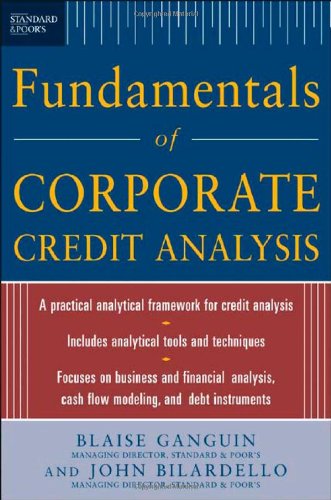Standard & Poor's Fundamentals of Corporate Credit Analysis book
Par lopez terry le dimanche, juin 26 2016, 05:41 - Lien permanent
Standard & Poor's Fundamentals of Corporate Credit Analysis. Blaise, Ganguin

Standard.Poor.s.Fundamentals.of.Corporate.Credit.Analysis.pdf
ISBN: 0071454586, | 463 pages | 12 Mb

Standard & Poor's Fundamentals of Corporate Credit Analysis Blaise, Ganguin
Publisher: McGraw-Hill
Standard & Poors analysts discuss the analysis on its Credit Matters website. Download Standard & Poor's Fundamentals of Corporate Credit Analysis. Credit ratings published by Moody's, Standard and Poor's and Fitch are meant to capture and categorize credit risk. However, institutional investors in corporate bonds often supplement these agency ratings with their own credit analysis. The scenario planning method; Market-based measures; Fundamental analysis of credit issuers and issues; Third-party assessments. Fourth: There is fear in European markets that are overriding fundamentals these banks: As economies in Europe continue to deterioriate (which has already been calculated into many Italian and Spanish firms, among others), S&P continues to keep banks on credit watch on the possibility of further contraction. Though Bermuda has seen its outlook adjusted, like a number of other jurisdictions, the Government said they “pleased that the underlying fundamentals and strengths of our Bermuda economy have been recognised and that we have not been downgraded.”. [Updated] Ratings agency Standard & Poor's [S&P] has lowered its outlook on Bermuda from stable to negative and affirmed its 'AA-/A-1+' long- and short-term issuer credit ratings [ICR] on the island. What appears to be underway is a possible situation where fundamental and technical analysis signal two very different outcomes. The Scenario In a recent academic working paper, tilted “Credit Ratings and Credit Risk,” Brandeis University's Jens Hilscher and Oxford University's Mungo Wilson demonstrate that credit ratings by Standard & Poor's dating back to 1986 are outperformed by a simple model in predicting corporate failure. Perhaps most significantly the scenario saw the fundamental business model of these companies called into question. S&P's report is titled “Emerging market Credit Metrics: Ratings Trends in China Turn Negative.” The report is from the Global Fixed Income Research unit and S&P points out that corporate downgrades are edging up as investors continue to wait for China to inject more stimulus. Discovery and Carbon Tracker recently collaborated with global credit-ratings agency Standard & Poors to publish 'What a carbon-constrained future could mean for oil companies' creditworthiness'. The first question dives into the reason why many sub divisions of financial institutions saw credit ratings higher than the full corporation themselves. Made by Richard Smith of the Australian Broadcasting Corporation.